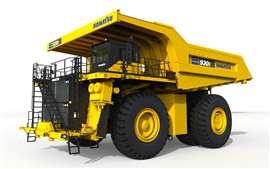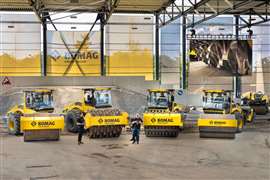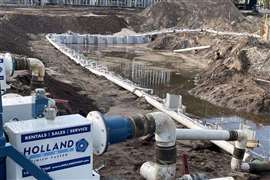Komatsu, GM collaborate on fuel cell mining truck
12 December 2023
GM to expand vision of an all-electric future to include the heaviest-duty applications
 A front 3/4 view of a virtual rendering of Komatsu’s 930E mining truck that will be powered by Hydrotec fuel cells. (Illustration: Komatsu)
A front 3/4 view of a virtual rendering of Komatsu’s 930E mining truck that will be powered by Hydrotec fuel cells. (Illustration: Komatsu)
General Motors and Komatsu will co-develop a hydrogen fuel cell power module for Komatsu’s 930E electric drive haul truck. GM, with its hydrogen fuel cell technology, and Komatsu, a global manufacturer of mining and construction equipment, will jointly design and validate the technology.
“Finding new ways to power the equipment our customers need to do the vital work of mining and construction is a critical part of our commitment to supporting a more sustainable future,” said Dan Funcannon, vice president of North America engineering and development for Komatsu. “This is essential work that requires cross-industry collaboration, and we are excited to be working with GM on this important solution for a haulage offering without tailpipe emissions.”
Lightweight and quick to refuel, Komatsu said hydrogen fuel cells are ideal for electrifying applications traditionally powered by diesel engines. Hydrogen provides an effective method to package large quantities of energy onboard the vehicle, without compromising payload carrying capacity. Additionally, fuel cells provide a zero tailpipe emissions solution for vehicles with extreme hauling requirements, like the Komatsu 930E mining truck, with its nominal payload of 320 tons. These vehicles typically operate at a single mine throughout their life, which simplifies the challenges of sizing and deploying an effective hydrogen refueling infrastructure to service the vehicle fleet.
“At GM, we believe fuel cells can play an integral role in a zero-emissions future, helping to electrify heavier-duty applications, beyond passenger vehicles,” said Charlie Freese, executive director of GM’s global Hydrotec business. “Mining trucks are among the largest, most capable vehicles used in any industry, and we believe hydrogen fuel cells are best suited to deliver zero emissions propulsion to these demanding applications.”
Komatsu’s fuel cell-powered mining trucks are expected to provide an additional pathway for decarbonization beyond battery-trolley or battery-static charging solutions, without the need for additional charging infrastructure within mines.
Komatsu set a target of reducing its global emissions by 50% by 2030 and a challenge target of achieving carbon neutrality by 2050. The company said its plans for achieving these goals include reducing and eliminating emissions within the company’s product offerings, as well as in the company’s facilities and production of its products. Komatsu also works closely with its customers on reducing and eliminating emissions during product use through optimization programs supported by Komatsu technology and service solutions.
GM’s target is to be fully carbon neutral in products and operations by 2040.
GM and Komatsu intend to test the first prototype mining vehicle in the mid-2020s at Komatsu’s Arizona Proving Grounds research and development facility. This vehicle will be powered by over 2 megawatts of Hydrotec power cubes.
GM has been conducting fuel cell research and product development for more than 50 years and offers homegrown technology platforms for lithium-ion batteries and hydrogen fuel cells. GM and Komatsu believe these complimentary technologies can help spur the adoption of lower-emission mobility solutions and help other industries beyond passenger vehicles meet their sustainability goals.
STAY CONNECTED



Receive the information you need when you need it through our world-leading magazines, newsletters and daily briefings.
CONNECT WITH THE TEAM












